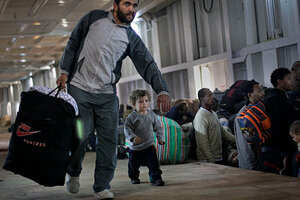Misrata emerges as deadly test of NATO clout in Libya
The NATO-led coalition taking on Muammar Qaddafi's forces in Libya are trying to show they can be effective without the US in a leading role. But so far, they've been able to do little to stop the humanitarian crisis in rebel-held Misrata.

An evacuee and his child prepare to disembark as nearly 1,200 migrant workers who were evacuated from Misrata by boat, many suffering from dehydration and needing medical attention, arrived at the port in Benghazi, Libya, Friday.
Ben Curtis/AP
Washington
An experiment is playing out in the Libya conflict to see if a global power other than the United States can lead an armed humanitarian intervention.
So far for the people of Misrata, the experiment is not going so well.
The only city in western Libya under rebel control is under siege from the forces of Muammar Qaddafi. And the international coalition’s NATO-led campaign tasked with protecting Libyan civilians has failed to stop Colonel Qaddafi’s rockets, mortars, and sniper fire.
One reason explaining NATO’s lack of impact on Qaddafi’s siege is that the international coalition does not have the kind of precision air power that could take out mobile weapons like tanks and rocket launchers, some military experts say. The US does have the kind of ground-attack fighters that could be more effective – the AC-130 and A-10 Warthog – but those have been pulled from the coalition arsenal as the Obama administration has opted to pull back to a support role.
Reporting from Misrata, the group Human Rights Watch said Monday that indiscriminate rocket and mortar attacks on residential neighborhoods were partly responsible for more than 265 deaths recorded by hospital morgues since April 15. Hospital officials claim that more than 1,000 people – mostly civilians – have been killed since fighting began in early March, although the figures are almost impossible to confirm.
One attack by a Soviet-era Grad rocket killed at least eight people waiting in line for bread, according to the New York-based Human Rights Watch.
NATO said in a statement Monday that it flew 60 missions on Sunday to attempt to identify ground targets in Libya, and it also reported taking out four air-defense radar installations in Misrata. Despite that, rebel commanders in Misrata have told the few foreign journalists there that they have repeatedly communicated the coordinates of Qaddafi’s forces to the NATO mission but have seen no response.
The United Nations has attempted, so far unsuccessfully, to get Qaddafi to stop the siege of Misrata, Libya’s third-largest city. The UN’s undersecretary general for humanitarian affairs, Valerie Amos, said in Benghazi Monday that the government in Tripoli has agreed to allow humanitarian assistance to enter Misrata, although it did not commit to halting attacks to allow aid to flow in safely.
Ms. Amos acknowledged that the siege of Misrata continues unabated, with little reliable information trickling out about the scope of the humanitarian crisis there.
“I’m extremely worried about the situation there, I very much hope that the security situation will allow us to get into Misrata,” she told journalists. “Nobody has any sense of the depth and scale of what is happening there,” she said.
The International Organization for Migration (IOM) has managed to get a few ships to Misrata to evacuate stranded foreign workers, but the Geneva-based intergovernmental organization said in a statement Monday that conditions for rescue work are quickly deteriorating.
“We wanted to be able to take more people out but it was impossible,” said the IOM official leading the evacuation operation, Jeremy Haslam. Describing intermittent exchanges of fire, he added, “We had a very limited time to get the migrants and Libyans on board the ship and then leave.”
Libyan government officials said Sunday that the deal worked out with the UN on humanitarian aid to Misrata includes “safe passage” for refugees to leave the city, but they did not commit to halting the fight.
The IOM ship that left Monday morning was carrying nearly 1,000 migrant workers, mostly from Ghana, and some wounded Libyans. Since Friday, the IOM has evacuated about 2,200 migrant workers and Libyans from Misrata to Benghazi in eastern Libya. But the organization reports that at least 4,000 migrants, mostly Nigerians, remain stuck at the city’s port.
